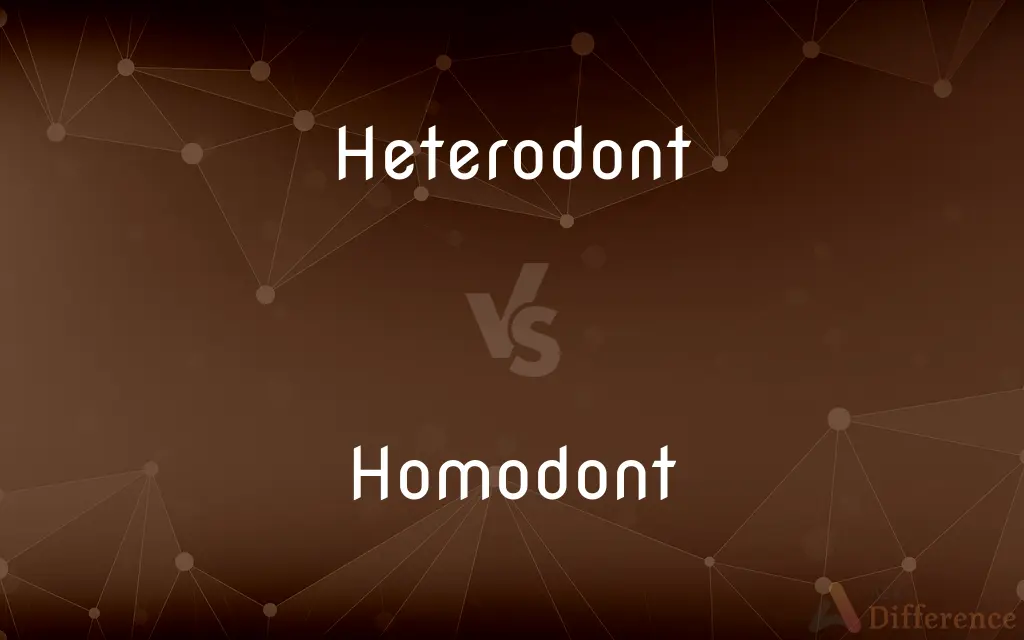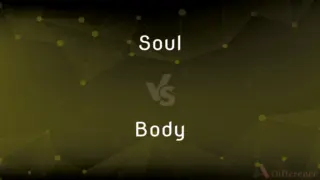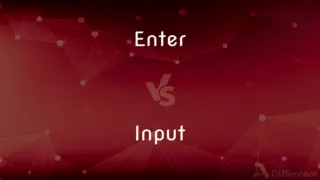Heterodont vs. Homodont — What's the Difference?
By Tayyaba Rehman & Fiza Rafique — Updated on March 29, 2024
Heterodont dentition refers to animals with different types of teeth (incisors, canines, molars) specialized for various functions, whereas homodont dentition signifies species having teeth that are all the same shape, seen in most reptiles and fish.

Difference Between Heterodont and Homodont
Table of Contents
ADVERTISEMENT
Key Differences
Heterodont dentition is a characteristic of many mammals, including humans, which have a variety of teeth types such as incisors, canines, premolars, and molars, each specialized for different tasks like cutting, tearing, and grinding food. Whereas, homodont dentition features teeth that are uniform in shape, with little to no variation in form across the entire set, common among reptiles, fish, and some marine mammals, which reflects a diet or feeding behavior that does not require the differentiation of teeth.
In heterodont dentition, the diversity in tooth structure allows for a more efficient processing of a wide range of food materials, from meats to plants, adapting to the animal's dietary needs. On the other hand, homodont creatures typically exhibit feeding habits that are more specialized or less varied, relying on a simpler tooth design to capture, hold, or slightly process their food before swallowing.
The evolution of heterodont dentition is associated with the dietary adaptations of terrestrial mammals, facilitating the consumption and digestion of a diverse diet. Homodont dentition, however, is seen as a more primitive or specialized trait, where the uniformity of teeth simplifies the structure of the mouth and often corresponds to a specific feeding strategy.
The presence of different types of teeth in heterodont animals also plays a critical role in other functions beyond feeding, such as defense and manipulating objects. Whereas in homodont animals, the teeth are primarily used for the initial capture or intake of food, with less emphasis on processing within the mouth.
Adaptability to different environments and dietary resources is a hallmark of heterodont dentition, allowing animals to exploit a wider range of food sources. In contrast, homodont dentition suggests a lifestyle that is either more specialized or constrained by the available dietary options, reflecting an evolutionary trade-off between simplicity and versatility.
ADVERTISEMENT
Comparison Chart
Types of Teeth
Multiple types: incisors, canines, premolars, molars
Uniform shape throughout
Dietary Adaptation
Allows for a diverse diet, including meats and plants
Often corresponds to a specialized or less varied diet
Evolutionary Significance
Associated with the dietary adaptations of terrestrial mammals
Seen as more primitive or specialized, common in reptiles and fish
Function Beyond Feeding
Teeth can serve multiple functions, including defense and manipulation
Primarily used for capture or intake of food
Adaptability
High adaptability to different environments and dietary resources
More specialized or constrained by available dietary options
Compare with Definitions
Heterodont
Dentition comprising different types of teeth for various functions.
Humans use incisors to cut, canines to tear, and molars to grind food.
Homodont
Common in many aquatic and reptilian species.
Sharks replace their uniform, sharp teeth throughout their lives to maintain efficiency.
Heterodont
Characteristic of mammals, showing evolutionary adaptation.
The heterodont dentition of a dog allows it to process both meat and bones efficiently.
Homodont
Dentition where all teeth share the same shape.
Alligators possess homodont teeth suited for grasping and holding prey.
Heterodont
Indicates multi-functional use of the mouth.
Elephants use their molars to grind plant matter, while their tusks (modified incisors) serve for defense and manipulation.
Homodont
Suited for specialized diets or feeding strategies.
Dolphins use their homodont teeth to catch fish, their primary food source.
Heterodont
Supports complex feeding behaviors.
The varied teeth of a chimpanzee enable it to eat fruits, nuts, and insects.
Homodont
Reflects a simpler or more primitive dental structure.
The uniform teeth of a snake are designed to grip prey for swallowing whole.
Heterodont
Reflects dietary versatility and adaptability.
Bears exhibit heterodont dentition to handle both plant and animal matter.
Homodont
Associated with specific evolutionary paths.
The homodont dentition of fish facilitates the capture of prey in a water environment.
Heterodont
In anatomy, a heterodont (from Greek, meaning 'different teeth') is an animal which possesses more than a single tooth morphology.In vertebrates, heterodont pertains to animals where teeth are differentiated into different forms. For example, members of the Synapsida generally possess incisors, canines ("eyeteeth"), premolars, and molars.
Homodont
(zoology) Having teeth that are all of the same type.
Heterodont
(zootomy) Having teeth of different types (like most mammals).
Homodont
(zoology) Any organism with teeth all of the same type.
Heterodont
(malacology) Of bivalves or their hinge teeth: having two to three wedge-shaped cardinal teeth set in the centre near the umbones, generally also with elongated lateral teeth on the anterior and posterior margins.
The heterodont arrangement is characteristic of the Venus clams and cockles.
Homodont
Having all the teeth similar in front, as in the porpoises; - opposed to heterodont.
Heterodont
(zoology) A heterodont animal.
Heterodont
(malacology) A heterodont bivalve.
Heterodont
A snake of the genus Heterodon which is native to North America.
Heterodont
Having the teeth differentiated into incisors, canines, and molars, as in man; - opposed to homodont.
Heterodont
Any animal with heterodont dentition.
Common Curiosities
What is heterodont dentition?
Heterodont dentition refers to having teeth of different types and shapes, specialized for various functions such as cutting, tearing, and grinding.
Why is heterodont dentition important?
It allows animals to adapt to a wide range of dietary needs, supporting complex feeding behaviors and other functions like defense.
What animals have homodont dentition?
Reptiles like alligators, aquatic animals like dolphins, and most fish exhibit homodont dentition.
What animals have heterodont dentition?
Many mammals, including humans, dogs, and bears, have heterodont dentition, allowing them to process a diverse diet.
Does the presence of homodont dentition imply a less complex diet?
Often, but not always; it often indicates a diet that does not require the differentiation of teeth for processing.
What is homodont dentition?
Homodont dentition means all teeth are of the same shape and size, common in reptiles, fish, and some marine mammals.
Do all mammals have heterodont dentition?
Most mammals do, but there are exceptions, especially among marine mammals.
Is homodont dentition less effective than heterodont dentition?
Not necessarily; it can be highly effective for species with specialized diets or feeding strategies.
How does dentition affect an animal's feeding behavior?
Dentition directly influences how an animal can process food, impacting its diet and feeding strategies.
How does heterodont dentition differ from homodont dentition in evolutionary terms?
Heterodont dentition is associated with the dietary adaptations of terrestrial mammals, while homodont dentition is seen as more primitive or specialized.
Are there any advantages to having homodont dentition?
Yes, it can simplify the structure of the mouth and is efficient for certain feeding strategies.
Can animals with homodont dentition eat a varied diet?
While some can consume a variety of foods, their dentition is generally more suited to a specialized diet or feeding strategy.
Are there exceptions to the typical characteristics of heterodont and homodont dentition?
Yes, nature is diverse, and there are always exceptions to general rules, reflecting the complexity of evolutionary adaptation.
Can the type of dentition change within a species over time?
Evolutionary pressures can lead to changes in dentition, but this occurs over very long timescales.
Can heterodont animals also have a specialized diet?
Yes, despite their varied dentition, some may specialize based on available resources or evolutionary niche.
Share Your Discovery

Previous Comparison
Soul vs. Body
Next Comparison
Enter vs. InputAuthor Spotlight
Written by
Tayyaba RehmanTayyaba Rehman is a distinguished writer, currently serving as a primary contributor to askdifference.com. As a researcher in semantics and etymology, Tayyaba's passion for the complexity of languages and their distinctions has found a perfect home on the platform. Tayyaba delves into the intricacies of language, distinguishing between commonly confused words and phrases, thereby providing clarity for readers worldwide.
Co-written by
Fiza RafiqueFiza Rafique is a skilled content writer at AskDifference.com, where she meticulously refines and enhances written pieces. Drawing from her vast editorial expertise, Fiza ensures clarity, accuracy, and precision in every article. Passionate about language, she continually seeks to elevate the quality of content for readers worldwide.
















































